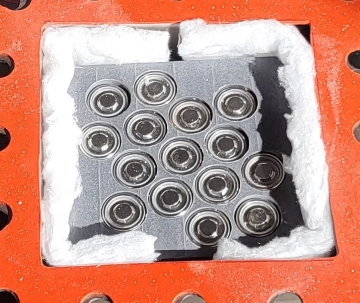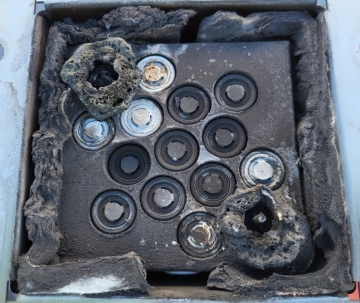SABIC TESTING SHOWS HIGH POTENTIAL OF PHASE-CHANGE THERMOPLASTICS IN PREVENTING THERMAL RUNAWAY IN EV BATTERIES
SABIC, a global leader in the chemical industry, is reporting here at NPE2024 test results that underline the high potential of thermoplastic-based thermal runaway barrier solutions to help prevent fire spread in electric vehicle (EV) batteries. The SABIC sub-system level test series showed that a battery module box made from the company’s STAMAX™ 30YH570 long glass fiber polypropylene (PP) resin with intercellular thickness as low as 1mm has a potential to act as an effective thermal barrier solution by preventing thermal runaway propagation in 18650 cylindrical cells. It provides the necessary thermal insulation and flame resistance to reduce the chances of cell-to-cell propagation in a thermal runaway scenario and thus mitigate the risks of a catastrophic safety incident. This material in combination with compressible foams also has shown promising results to contain thermal runaway propagation in prismatic and pouch cells.
Visitors to SABIC’s NPE booth (#S19005) can view the tested thermoplastic battery module box in a display area dedicated to BLUEHERO™, an initiative designed to help the automotive industry shift to electric power and a low-carbon future. They can also explore other EV battery components made with SABIC’s materials, such as module enclosures, busbars and end plates, on display at the booth.
The new results build upon previous independent evaluations of SABIC’s STAMAX 30YH570 resin. In 2023, the product earned the UL Verified Mark from Underwriters Laboratories for effective flame delay performance. The assessment was based on UL 2596, the Test Method for Thermal and Mechanical Performance of Battery Enclosure Materials, using the thermal runaway box test.
“We are pleased to share this additional validation of our thermoplastic solutions’ strong potential for use in EV battery components and systems,” Fahad Al-Harthi, global director, Automotive, SABIC Polymers, said “Our portfolio of flame-retardant materials, combined with our expertise in application design and fire-polymer interaction, can help enable new thermal runaway barrier approaches. We look forward to continued collaboration across the automotive value chain to help improve the safety, efficiency and performance of EV battery systems.”


Left: Cylindrical battery cells arranged within a thermal runaway barrier made of SABIC’s flame retardant STAMAX™ resin with a minimum intercellular gap of 1.0 mm, before thermal runaway test.
Right: Same battery cell module after thermal runaway test, with evidence of no propagation from trigger cells (top left cell and bottom right cell) to neighboring cells.
Thermal Runaway Barrier Testing
The thermal runaway propagation tests, highlighted here at NPE, are performed using a cluster of 15 commercial 18650 and 11 21700 lithium-ion battery cells enclosed in a steel chamber, with and without injection-molded STAMAX 30YH570 resin blocks serving as a thermal barrier. Initiating cells were thermally abused by heating them through an electrical tape to begin thermal runaway. In tests without the thermal barrier in place, the electric and chemical energies stored in these cells were discharged in the form of high-temperature gas, open flame, high-speed particles, and a sudden increase of pressure inside and around the test chamber. The thermal runaway immediately propagated to all neighboring cells due to the uncontrolled heat transfer, creating fire hazards and severe damage to the EV battery pack.
Conversely, in the tests using the thermal barrier made from STAMAX 30YH570 resin, heat transfer and thermal propagation from thermal abuse of initiating cells were effectively suppressed, and all remaining cells remained safe and intact.
This flame-retardant material changes phase from solid to liquid and gas and removes heat via latent heat and intumescent capabilities during severe thermal events, allowing it to act as an effective thermal shield to mitigate heat transfer and fire spread.
Potential Solutions for EV Batteries and More Automotive Applications
SABIC is also highlighting at NPE EV battery applications that successfully use the company’s advanced thermoplastics. One is the battery module from the 2023 Hyundai IONIQ 6. This application uses SABIC® polypropylene compound H1030 for module enclosures. This is a 30 percent glass fiber-reinforced, non-halogenated flame-retardant material that meets China’s GB/T 41467.3-2015 fire safety regulation for EVs surviving five minutes at 1,000°C.
Additional EV battery components on display, such as enclosures, end plates and busbars, either in production or developed as prototypes, help demonstrate various performance advantages of thermoplastics over conventional metals for these applications. They include weight and cost reduction, increased functional integration, and enhanced electrical and thermal insulation.
SABIC has a display zone in its booth dedicated to automotive thermoplastic solutions. In addition to materials well suited for use in EV battery components, the company is highlighting technologies and expertise to support possible/potential solutions for automotive structural applications such as tailgates, lighting and smart panels.
An additional display zone in the booth focuses on SABIC’s capabilities to support customers’ product development efforts. Included in this space is a small-scale model of an EV battery pack enclosure with a cover and tray. Visitors can learn how the company developed this part, which includes integrated thermal runaway barrier features to support fire suppression and temperature management.














 粤公网安备 44190002005717号
粤公网安备 44190002005717号